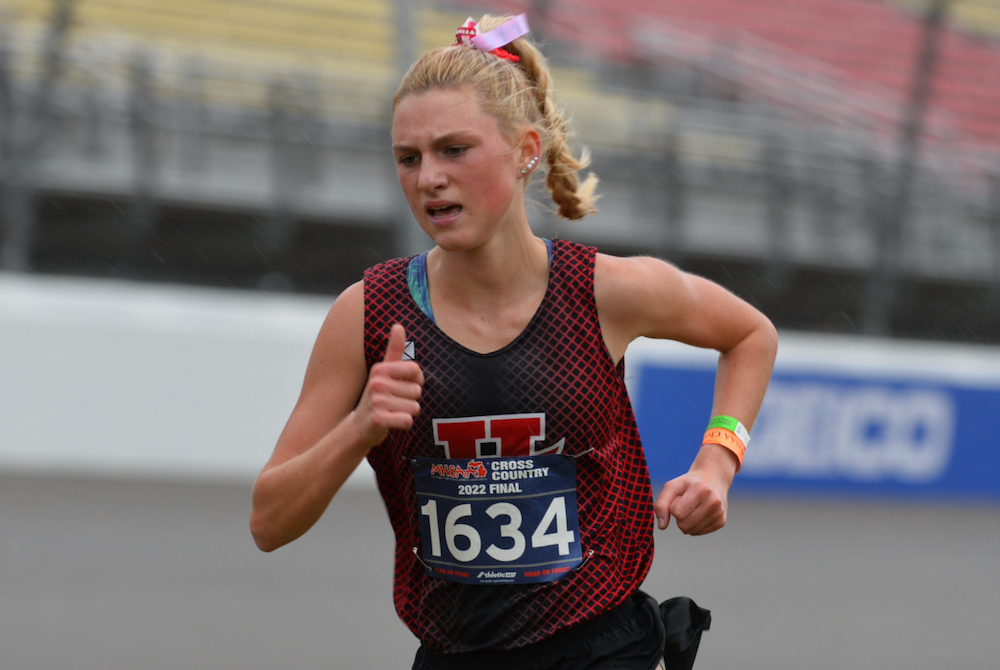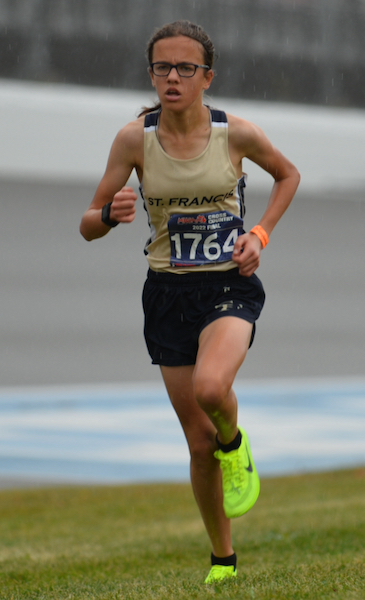
Sacred Heart, Strenge Surge Again
November 5, 2016
Second Half reports
BROOKLYN – Ava Strenge and Bailley McConnell both got what they came for Saturday.
 Strenge, a Battle Creek St. Philip senior, reclaimed the MHSAA Lower Peninsula Division 4 individual cross country championship with a powerful front-running performance at Michigan International Speedway.
Strenge, a Battle Creek St. Philip senior, reclaimed the MHSAA Lower Peninsula Division 4 individual cross country championship with a powerful front-running performance at Michigan International Speedway.
McConnell, a distant individual runner-up, helped her Mount Pleasant Sacred Heart team post another record-breaking point total en route to the team championship.
Strenge led from start to finish, winning the race in 18:27.2.
McConnell was second in 18:55.6, leading a dominant Sacred Heart team that had six all-state runners and a seventh who missed by one place.
The Irish broke the Division 4 record of 52 points they scored last year by scoring 34, beating runner-up Pewamo-Westphalia by 82. Sacred Heart’s total ranks sixth all-time in any division and is the lowest since Rockford won Class A with 25 points in 1998.
“It’s awesome,” said McConnell, a junior. “It’s good to be a team and work together, cheer each other on and be really close to each other. Sometimes we get to run with each other during the race.
“We were hoping to make another record. We’ve had some injuries and sicknesses, so we were just hoping to maintain that.”
There have been some great sister acts in MHSAA cross country history, but nothing like the McConnells.
Not only was Bailley second, but senior Alexis McConnell was fourth in 19:09.1 and sophomore Cammie McConnell was fifth in 19:10.6.
“I went out with my sisters,” Bailley said. “They like to pace me a lot and I like to pace with them, so we just kind of stayed back. Each mile, we’d see the time and I’d push harder so I could keep a constant pace.”
 Also scoring for Sacred Heart were sophomore Lauren MacDonald (11th, 19:41.0) and sophomore Scout Nelson (20th, 20:09.8). No. 6 runner Desiree McConnell’s place didn’t count in the team score, but she was still all-state with her 26th-place showing in 20:14.2. Even No. 7 runner Rowan Fitzpatrick almost made all-state, missing by one spot by placing 31st in 20:28.0.
Also scoring for Sacred Heart were sophomore Lauren MacDonald (11th, 19:41.0) and sophomore Scout Nelson (20th, 20:09.8). No. 6 runner Desiree McConnell’s place didn’t count in the team score, but she was still all-state with her 26th-place showing in 20:14.2. Even No. 7 runner Rowan Fitzpatrick almost made all-state, missing by one spot by placing 31st in 20:28.0.
Strenge was the Division 4 champion two years ago. She led most of last year’s race before being run down by Tessa Fornari of Waterford Our Lady of the Lakes.
“It was kind of a shock to me,” Strenge said. “I was disappointed, but I still had next year.”
Strenge was determined not to be caught again, charging to the front and pushing a hard pace. The way she pumped her arms was more in line with a middle-distance runner on the track than a cross country runner.
“I like to get out in front of the pack,” Strenge said. “Our start was way in the far corner. I wanted to get in the front as soon as possible. I’m not really a good sprinter, so I wanted a lead before they could pass me on the straightaway.”
The MHSAA Cross Country Finals are sponsored by the Michigan National Guard.
PHOTOS: (Top) Sisters Alexis McConnell (1857) and Cammie McConnell run to top-five finishes in the Division 4 girls race Saturday. (Middle) Battle Creek St. Philip’s Ava Strenge sprints the final stretch to win her second individual title in three seasons. (Click to see more from RunMichigan.com.)

Jazwinski Brings Hart Individual Title as St. Francis Moves to Front of Team Pack
November 5, 2022
BROOKLYN – Cross country races can be won between the ears before runners ever step foot onto the course.
Attitudes were tested as rain began to descend on Michigan International Speedway and the wind picked up just before the start of the MHSAA Lower Peninsula Division 3 girls race late Saturday morning.
Hart sophomore Jessica Jazwinski was loving life as she prepared to race.
“As a distance runner, I really try to love the wind,” she said. “Distance running and cross country is just a tough sport. The wind just adds to it — and the rain, too. It’s super fun.
“I was just thinking these conditions are just gonna feed my great race. This is real cross country. Yeah!”
Jazwinski overcame the elements to run the fifth-fastest Division 3 time ever, winning with a time of 17:36.70. She has two of the top-five times in Division 3 Finals history, having run 17:31.4 to place third last year.
“Today my race plan was just to go out hard and try to hold on to my pace,” she said. “I feel like I tried to race a lot like Steve Prefontaine, just go out and hold on.”
 Lansing Catholic senior Hannah Pricco was second in 18:17.59, Onsted sophomore Emmry Ross was third in 18:20.96 and Hart junior Alyson Ens was fourth in 18:28.52.
Lansing Catholic senior Hannah Pricco was second in 18:17.59, Onsted sophomore Emmry Ross was third in 18:20.96 and Hart junior Alyson Ens was fourth in 18:28.52.
“I love having great teammates to work with and encourage each other,” Jazwinski said. “We really try to encourage each other so much throughout the races. Throughout this year, some races she’s been a minute behind me, some races she’s been five seconds. I don’t want her to ever beat me, so that pushes me so much. I know she’s trying to race me and get up there with me.”
The only downer for Hart was having its string of Division 3 championships end at five with a fourth-place finish. Hart had two runners in the top four, but its No. 3 runner was 68th.
“I would totally trade my individual title for a team title,” Jazwinski said.
Traverse City St. Francis emerged from a close battle to win its first title since 2016 with 134 points. Pewamo-Westphalia was second with 142 and Lansing Catholic third with 165.
Sophomore Betsy Skendzel led St. Francis, placing seventh in 18:48.33. Completing the team score were senior Sophia Rhein in 26th (19:43.27), sophomore Grace Slocum in 33rd (20:07.95), junior Rylee Duffing in 60th (20:44.82) and junior Margot Hagerty in 63rd (20:45.78).
Lansing Catholic had three place in the top 10, but didn’t get another finisher until 103rd.
PHOTOS (Top) Hart’s Jessica Jazwinski pushes toward the finish during Saturday’s LPD3 Final. (Middle) Traverse City St. Francis’ Betsy Skendzel leads the way for the eventual team champion. (Click for more from Dave McCauley/RunMichigan.com.)

